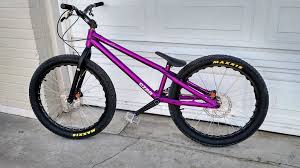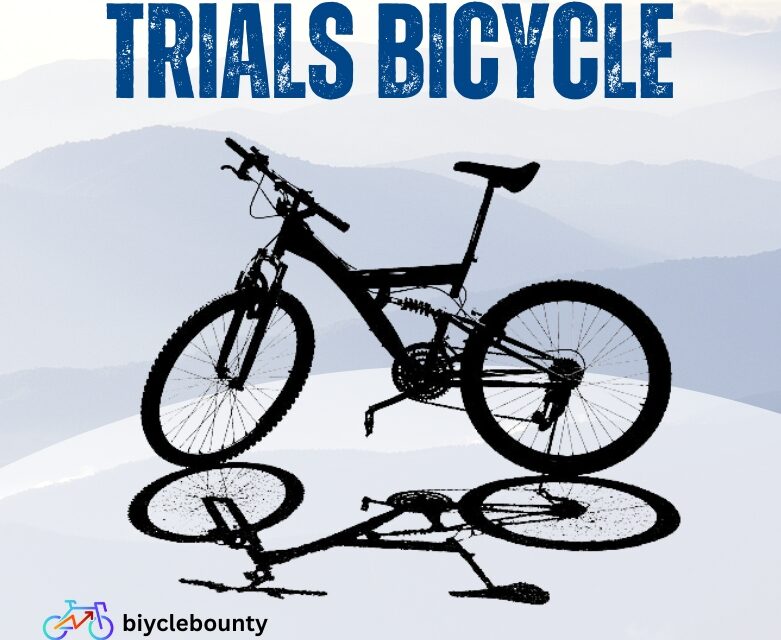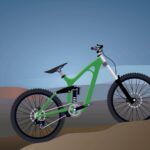The trials bicycle, also known as a competition bicycle or a trick bike, is a unique type of bicycle specifically designed for performing stunts and maneuvers. Unlike conventional bicycles, trials bikes lack a seat, featuring a small, padded platform instead. This modification allows for greater freedom of movement and superior bike control during jumps, wheelies, and other technical riding situations.
Table of Contents
Developed in the late 20th century, trials cycling has become a recognized extreme sport, with competitions held worldwide. Trials bikes themselves are highly specialized machines, built for exceptional strength and agility.
Trials Bicycle Features: Designed for Balance & Maneuvers
The trials bicycle, a master of balance and agility, thrives where conventional bikes falter. Forget leisurely cruises or smooth commutes – trials bikes are built for conquering technical terrain and defying gravity with mind-bending maneuvers. This specialized machine is a marvel of engineering, meticulously crafted to empower riders to navigate seemingly impossible obstacles. Let’s delve into the key features that define a trials bike and unlock its potential for mastering the art of trials riding.
Frame: A Foundation for Strength & Control
The heart of a trials bike is its frame, typically constructed from lightweight yet robust materials like chromoly steel or aluminum. This balance of weight and strength is crucial. Lighter frames allow for easier maneuverability and quicker acceleration, essential for tackling challenging climbs and navigating tight spaces. However, trials bikes also need to withstand the rigors of jumps, drops, and collisions with rocks. Chromoly steel offers a good compromise, while high-end bikes might utilize lighter but potentially more delicate aluminum frames.
The geometry of the frame is another defining characteristic. Unlike traditional bicycles with a sloping top tube, trials bicycle have a much more upright design. This “long and high” geometry features a raised bottom bracket, creating a higher center of gravity. This might sound counterintuitive for stability, but it actually serves two key purposes.

First, it allows the rider to easily lift the front or rear wheel over obstacles without feeling like they’re going to topple over. Second, it provides better clearance for the rider’s legs during technical maneuvers like manuals (balancing on the rear wheel) and wheelying (balancing on the front wheel). The frame will also typically have a short wheelbase (the distance between the axles) for increased maneuverability in tight spaces.
Drivetrain: Gearing Up for Low-Speed Power
Trials bikes are single-speed machines, meaning they lack the gear shifters and derailleurs found on most bicycles. This minimalist approach reduces weight and simplifies maintenance. However, the gearing is specifically chosen for the demands of trials riding. Trials bikes use a low gear ratio, achieved by a small chainring upfront and a larger cog (sprocket) in the rear. This setup prioritizes torque (turning power) over speed, allowing the rider to climb steep inclines, power through obstacles, and maintain precise control at slow speeds. Some riders might opt for slightly higher gear ratios for street trials, which often incorporates faster sections compared to pure competition-style riding.
Brakes: Precision and Power for Maneuvering
Brakes play a crucial role in trials riding, allowing for precise control over the bike during technical maneuvers. Trials bikes typically utilize hydraulic disc brakes, offering superior stopping power and modulation compared to traditional rim brakes. Hydraulic brakes rely on enclosed fluid lines instead of cables, resulting in a firmer, more responsive feel at the brake lever. This is vital for navigating tricky sections where precise control over the bike’s speed and momentum is paramount. Additionally, disc brakes are less affected by weather conditions like rain or mud, ensuring consistent performance.
Wheels and Tires: Gripping the Terrain
The wheels of a trials bicycle are built to withstand the harsh impacts of jumps, drops, and rocky terrain. They are typically smaller than mountain bike wheels, with 20″, 24″, and 26″ being the most common sizes. Smaller wheels offer greater maneuverability and quicker acceleration, but they also reduce ground clearance. The choice of wheel size often depends on rider preference and the type of trials riding being done. Street trials riders might opt for slightly larger wheels for increased speed and handling on smoother surfaces.
The tires on a trials bike are thick and knobby, designed to provide maximum traction on a variety of terrain, from loose dirt and rocks to concrete and wood. These tires feature a low tire pressure, further enhancing their ability to grip uneven surfaces and absorb impacts. However, the lower pressure also increases the risk of punctures, so riders need to be extra careful when navigating areas with sharp objects.

Other Key Features:
Several other features contribute to a trials bike’s unique design:
- Handlebars: Wide handlebars provide increased leverage and control during maneuvers.
- Pedals: Wide, platform pedals with good grip help the rider maintain a stable foot position while maneuvering.
- Bash Guard: A metal plate protects the chainring from damage caused by rocks and other impacts.
- Chain Tensioner: Since trials bikes lack derailleurs, a chain tensioner keeps the chain taut throughout maneuvers to prevent slippage.
Conclusion: A Symphony of Features
A trials bike is more than just the sum of its parts. It’s a meticulously designed machine where every feature works in harmony to create a platform for balance, agility, and precision. From the lightweight yet robust frame to the powerful brakes and grippy tires, each component plays a vital role in helping riders conquer seemingly impossible challenges. As you progress in your trials riding journey
you might consider customizing your bike to further optimize its performance for your riding style and the terrain you frequent. Here are some additional considerations:
- Suspension: While mosttrials bicycle are rigid (lack suspension), some high-end models incorporate lightweight front suspension forks. These can offer additional comfort and control on particularly rough terrain, but they add weight and complexity. The decision to add suspension depends on personal preference and riding style.
- Hydraulic Hose Length: The length of the hydraulic brake hoses can be adjusted to accommodate different riding styles and brake lever preferences. Shorter hoses offer a more direct feel at the lever, while longer hoses provide more flexibility for handlebar movement.
- Tire Choice: Different tire types cater to specific riding conditions. For example, softer tires with deeper treads offer superior grip on loose terrain, while harder tires with shallower treads provide better rolling resistance for smoother surfaces. Experimenting with different tire options can significantly impact your riding experience.
- Custom Components: For advanced riders, the world of aftermarket trials bike parts allows for further personalization. Lighter weight components like handlebars, stems, and cranks can shave precious grams off the overall weight of the bike. Upgraded brake pads can enhance stopping power in specific conditions.
Remember, the best trials bicycle is the one that feels most comfortable and allows you to push your limits with confidence. As you gain experience and refine your technique, you can tailor your bike’s setup to become an extension of yourself, ready to conquer any obstacle the trials world throws your way.
Beyond the Features: Skills and Safety
While a well-equipped trials bike is essential, mastering the art of trials riding goes far beyond its features. This physically demanding sport requires a high level of fitness, balance, and coordination. Dedication to practice and proper technique are paramount for success. Additionally, safety is a crucial aspect of trials riding. Always wear a helmet and appropriate protective gear, such as knee pads, elbow pads, and shin guards.
Trials riding offers a unique blend of challenge, reward, and adrenaline-pumping action. With the right bike, the right skills, and the right mindset, you can unlock a world of possibilities on two wheels, defying gravity and pushing the boundaries of what’s possible on a bicycle.










